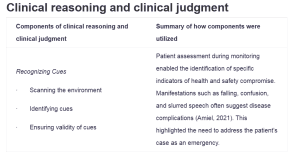Clinical reasoning and clinical judgment
| Components of clinical reasoning and clinical judgment | Summary of how components were utilized |
| Recognizing Cues
· Scanning the environment · Identifying cues · Ensuring validity of cues |
Patient assessment during monitoring enabled the identification of specific indicators of health and safety compromise. Manifestations such as falling, confusion, and slurred speech often suggest disease complications (Amiel, 2021). This highlighted the need to address the patient’s case as an emergency. |
| Analyzing Cues
· Clustering cues · Differentiate relevant or irrelevant information |
The patient’s manifestations suggested a health decline. They may have been due to a deteriorating health status or safety compromises in the treatment process. |
| Hypothesis
· Generate hypothesis · Prioritize hypothesis · Predict potential complications |
The reported symptoms provided insights into a possible stroke attack or adverse events related to the administered medications. Stroke is a common complication of hypertension and diabetes and is thus a probable differential in the case. Adverse events related to drug interaction are possible due to the high-risk potential of concurrently administering Sitagliptin and Pantoprazole (Ray et al., 2021).
The hypoglycemia may have been a consequence of medication interactions. Notably, hypoglycemia may result in death if not managed promptly. |
| Generate Solutions
· Select solutions/interventions · Manage potential complications · Set priorities |
Several interventions can be done to address the situation. These include reversing hypoglycemia, educating the nurses on drug interactions, and fostering collaborative paradigms to prevent subsequent attacks. The priority intervention is to reverse the complication. This can be attained by administering glucose, which will help alleviate the hypoglycemia manifestations (Lowe et al., 2022). |
| Action
· Collaboration with other team members · Implement solutions · Delegate · Communicate · Teaching |
To address the concern and prevent future incidences, a collaborative approach to patient management will be employed. In this case, nurses-pharmacists-physician collaborative paradigms in designing therapeutic care plans will be fostered to reduce the potential for drug interactions. The healthcare team will be educated on drug interactions. A communication system will also be established to allow nurses to engage other caregivers during medication handling (Szafran et al., 2019). |
| Evaluate
· Evaluate data · Reflect and correct reasoning process |
Acute hypoglycemia is a life-threatening health complication. Addressing it is thus a priority. Early symptom recognition allows the initiation of address measures. The outlined approach allows for effective management of the client in the case presented. |
References
Amiel, S. A. (2021). The consequences of hypoglycaemia. Diabetologia, 64(5), 963–970. https://doi.org/10.1007/s00125-020-05366-3
Lowe, R. N., Williams, B., & Claus, L. (2022). Diabetes: How to manage patients experiencing hypoglycaemia. Drugs in Context, 11, 1–12. https://doi.org/10.7573/dic.2021-9-11
Ray, C.-Y., Wu, V. C.-C., Wang, C.-L., Tu, H.-T., Huang, Y.-T., Kuo, C.-F., & Chang, S.-H. (2021). Hypoglycemia associated with drug–drug interactions in patients with type 2 diabetes mellitus using dipeptidylpeptidase-4 inhibitors. Frontiers in Pharmacology, 12. https://doi.org/10.3389/fphar.2021.570835
Szafran, O., Kennett, S. L., Bell, N. R., & Torti, J. M. (2019). Interprofessional collaboration in diabetes care: Perceptions of family physicians practicing in or not in a primary health care team. BMC Family Practice, 20(1). https://doi.org/10.1186/s12875-019-0932-9
ORDER A PLAGIARISM-FREE PAPER HERE
We’ll write everything from scratch
Question
Assignment Content
Competencies
- Evaluate factors integral to clinical reasoning.
- Explain the impact of relational inquiry when recognizing and analyzing cues to action in the context of clinical reasoning.
- Integrate modes of inquiry to generate and evaluate hypotheses in the context of clinical reasoning.
- Determine appropriate responses when integrating situated cognition into clinical reasoning.
- Modify clinical judgment within an iterative, outcome-based cycle of clinical reasoning and client needs.
- Evaluate the importance of personal and professional lifelong learning, including the interrelationships of clinical reasoning and clinical judgment.
Scenario
You applied to become a preceptor for nursing students. Part of the application process requires you to select a client who presented unique challenges to care based on changes in condition. Before the interview, you must submit the SBAR and clinical reasoning and clinical judgment templates for the selection committee to review.
Instructions
- Choose a client from a previous clinical experience that encountered a change in condition and provided challenges to care.
Complete all components of the SBAR template using information from this previous clinical experience.
SBAR Template.docx

Clinical reasoning and clinical judgment
Part II
Complete the clinical reasoning and clinical judgment template,
- Clinical Reasoning and Clinical Judgment Template.docx
including summaries of these components of clinical reasoning and clinical judgment:
- Recognizing Cues, including scanning the environment, identifying cues and ensuring the validity of cues, supported with examples and rationales
- Analyzing Cues, including clustering cues and differentiating relevant and irrelevant information supported with examples and rationales
- Hypothesis, including generating hypotheses, prioritizing hypotheses, and predicting potential complications supported with examples, rationales and evidence from credible sources

